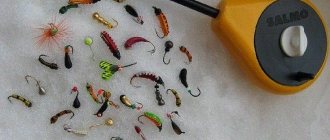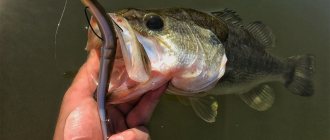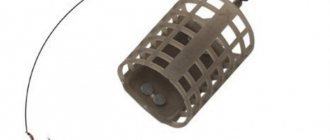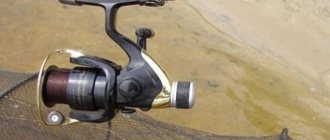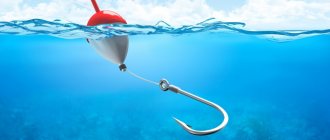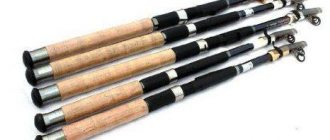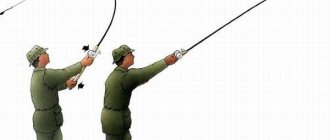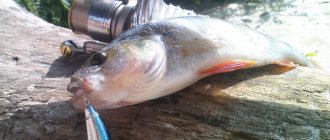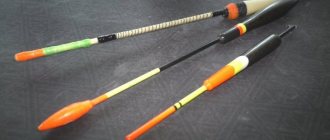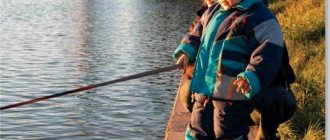What is a half-bottom?
Content
When asked what a half-bottom is, it is best to answer that it is a symbiosis of an ordinary float fishing rod and a donka. It is equipped with a rather heavy sinker, lying on the bottom and thereby making it possible to keep the hook in one place. The float does not keep the sinker afloat and is on the surface under the influence of the force of the current and the tension of the fishing line. It plays the role of a bite alarm when a fish grabs the bait.
If fishing occurs in a very strong current, it is recommended to move it towards the tip of the rod. In this case, it will not touch the water, but will act as a guard on a regular donk.
Half-bottoms are used very widely, as they have a number of advantages:
- Half-bottoms work well in strong currents if you choose the right load weight and fishing line thickness;
- they can be used for fishing in muddy water;
- due to the fact that the sinker does not stretch along the bottom and does not cling to snags or vegetation, but immediately gets to the right place, the likelihood of snags is very low;
- the equipment has increased sensitivity even to very careful bites, since the fishing line is always stretched and positioned almost vertically;
- can be used in fishing from shores overgrown with bushes, where other gear, for example, English donka, is difficult to use.
When a fish grabs the bait, the float acts as a bite alarm
Equipment
Converting a fishing rod into a half-bottom does not require much money or time. You can add a weight while fishing and move the float almost close to the rod.
The result is a simple version of a half-bottom, which will allow you to keep the hook in one place in a river with a weak current. It is difficult to fish with a float, sensitive tackle with a weight of 5–6 g, so you need to take care of equipping your rod at home.
Rod
More often they use simple swing “sticks” without additional rings and coils. The choice of length depends on the fishing location. If long casting is not required and the river depth is shallow, you can use a 4–5 m rod. For long-distance casting, we use a length of 6 m or make a half-bottom from a Bolognese rod.
Many fishermen do not like reels and rings on their rods, so fly rods are more popular for such equipment. If you are going to catch roach or bream from a boat, take a simple 3-meter bamboo fishing rod and enjoy active and exciting fishing.
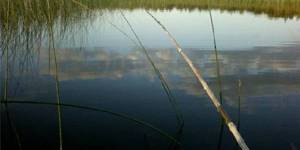
But during the spawning period, fishing from a boat is prohibited, so this applies to fishing in the summer or autumn.
Important! For ease of casting and retrieving, we take into account the rule - the length of the line should exceed the size of the “stick” by 300-400 mm. This type of tackle is easy to cast from any position, even while sitting in a fishing chair.
Sinker
The best option is to prepare gear for fishing in the middle current with a weight of 2–4 g and add a weight during fishing if it will be carried away by a strong current. The best option is to install 4-5 small weights on the main line.
Now the loads will lie at the bottom. With a sudden increase in current pressure or a jerk in the line, several sinkers come off the bottom, but the rest hold the tackle in place and sensitivity to cautious bites increases.
It is recommended to use a sliding sinker installation. You can mount the load in a similar way to the feeder tackle, when it moves to the feeder or leash with a hook. A hook on a leash that is loose in the water is not felt by cautious fish when biting, and its movements with the bait attract fish from a great distance.
Another advantage of such equipment is that it reduces the possibility of entanglement when casting and retrieving fish.
Float
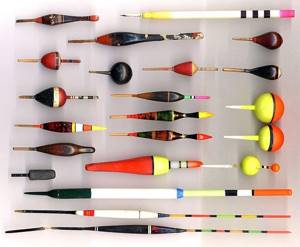
It all depends on the preference and vision of the fisherman. The main requirement is the same - it should not be large in size. Large dimensions increase windage, and the fisherman will react to every gust of wind, even a very weak one.
Many people prefer to use winter floats with bright colors. Some people like floats bought at a fishing store, others like homemade ones. There are no strict rules or recommendations in this matter.
Important! The main thing is to position the float correctly on the line. It should be no lower than 300 mm from the rod whip. During this interval, the alarm does not react to the wind, but will always indicate a fish bite.
Hooks
The choice depends on the size and type of fish, bait and other factors. There are no special differences from conventional gear in the choice of hooks. The hook should be sharp and comfortable for setting bait.
Main forest
In this matter, we remember the increased weight of the sinkers. As a result, we always use thicker line for half-bottoms than for float gear, even when catching fish of the same type and size.
Just as in the case of hooks, there are no special nuances in choosing a base. The fishing line should be “fresh”, without defects, with minimal “memory”, and hold knots well.
Leash
Using a leash, you can put the fishing hook on the bottom or raise it up to a distance of 40–50 mm. It is customary to install leashes of smaller diameter than the main line. This allows you to save all the tackle when hooked.
Their length is 150-300 mm - this length allows it to move freely in the current and attract fish to the bait.
In terms of diameter, leashes are selected depending on the size of the fish, most often using line with a cross section of 0.17-0.2 mm. Leashes can be secured by rigidly tying them to the main line, using the “loop to loop” principle, or by securing them with carabiners.
When installing a sliding sinker, stoppers are placed near the attachment point to maintain the integrity of the assembly.
Important! By installing the leash on the carabiner, you can easily replace it and install a hook suitable for fishing.
Varieties of half-bottoms
A half-bottom with a float is a simple tackle, but has two types of rigs used:
- half-bottom with a sinker - a basic, one might say, classic version of the half-bottom;
- half-bottom with a feeder - sometimes, in order to increase the catchability of the gear, a small feeder is placed on it, usually in the form of a spring. A lightweight compact cage feeder is also suitable. Considering the short distance of using the half-bottom, the task of the feeder is not to attract fish into the fishing zone, but to help the fish find the bait among the bait thrown manually.
Features of the bottom fishing rod
Bottom fishing rod A bottom fishing rod
is a baited hook used for fishing from the bottom or in the immediate vicinity of it. Bottom fishing rods, or casting rods (sometimes called casting rods), are usually equipped with heavy weights, which allows for long casting.
They are used for fishing from the shore, rafts, stationary boats on rivers and flowing reservoirs. Fishing in bodies of water without a current is less convenient due to the sag of the long line that is usually equipped with such fishing rods. When fishing in bodies of water without a current, slack in the line is eliminated with a counterweight attached to the line at the guard; when fishing in a current, its sagging is eliminated by the force of the current. Usually they use a rod 1 to 2 m long, with an elastic tip that can withstand a wide, energetic hook. Rods made from a whole juniper twig or combined rods - a bamboo butt with a juniper tip - have proven themselves well. The butt of the rod is sharpened or equipped with an iron spike so that it can be stuck into the ground, and reels, and the tip is equipped with a loop for securing the fishing line. When fishing with a reel, which is very convenient and advisable, 3-4 guide rings, a “tulip” ring and clamping rings for attaching the reel are installed on the rod. The usual length of fishing line is 25-30, and if there is a reel - 50 m. Thickness is 0.35-0.6 mm.
Choosing equipment for a half-bottom
One of the main advantages of the half-bottom is its simplicity of design. The tackle is built on the basis of a fly rod and a Bolognese rod up to 6 meters long. In rare cases, you may need a longer rod, but such gear will become a little clumsy and then it is better to use other fishing methods.
The absence or presence of passage rings on the form determines the need for a reel, the requirements for which are minimal - sufficient capacity to store 50-100 m of fishing line and the ability to easily return it when fishing for a large specimen. Thus, almost any inertial or non-inertial coils are suitable. When using a spinning reel, it is desirable that it has a high-quality friction brake.
Read more
How to catch perch on a donka?
A half-bottom, the equipment of which is built on the basis of a fly rod, can be equipped with a rubber shock absorber; it will allow the use of thinner fishing lines, which, in turn, will have a positive effect on the catchability and sensitivity of the tackle.
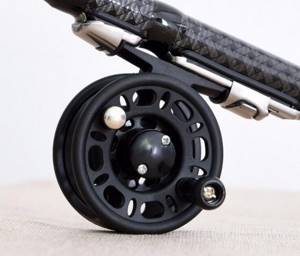
Inertia or inertia-free reels are suitable for half-bottoms
Main line
In half-bottom fishing, ordinary monofilament fishing lines are used. The diameter of the fishing line depends on the fishing conditions and, to a lesser extent, on the average size of the fish in the catch. If there are no hooks and a strong current, a fishing line of 0.12-0.14 mm will be enough. However, such “greenhouse” conditions do not always occur, so more often a fishing line with a diameter of 0.16-0.18 mm is placed on the half-bottom. Thicker lines are used, as a rule, by beginners and older fishermen due to inertia. Their only justification is the presence in the reservoir of a large number of large carp, grass carp, etc.
Leashes
The leashes in the half-bottom are selected similarly to the leashes of a float rod. That is, their diameter is usually 0.02-0.04 mm smaller than the main line. For example, with a fishing line of 0.14 mm, leashes of 0.10-0.12 mm are used.
The length of the leash can vary from 15 to 50 cm. As a rule, if there are a lot of unrealized bites, the length of the leash is increased, and when the fish often swallows the hook deeply, it is reduced. Also, the length of the leash is sometimes increased when the bite is bad.
Hooks
The size of the hook, as in other gear, depends on the size of the bait, but it must be combined with the rest of the equipment. Hooks can be used both designed for float fishing and feeder ones.
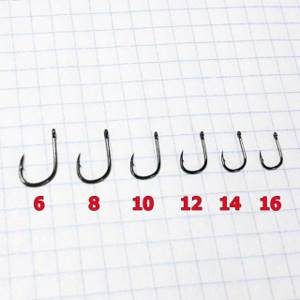
The size of the hook depends on the size of the bait
Sinkers
Proper weight is one of the key factors for successful fishing. The half-bottom rig in the current includes several sinkers distributed in a chain along the main line at a short distance or one sliding sinker. The latter option is more effective, since the concentration of the load at one point allows you to quickly lower the nozzle to the bottom, and the line, freely passing through the load, increases the sensitivity of the gear.
The weight of the sinkers is selected in such a way that the equipment is held at the bottom, while being on the verge of being carried away by the current. Excess weight of the sinker is harmful, as it worsens sensitivity, but at the same time its weight still remains insufficient to ensure self-hooking.
Float selection
There are two approaches to choosing a float, related to the different uses of the half-bottom. In the first, traditional case, the line is in a semi-tensioned state and the mass of the float should be enough to pull the line down and form an angle on it. A particularly large float with its own weight of 5 g or more is required, and the bite is detected by its movement. It is desirable that the shape of the float be spherical, as well as drop-shaped - this way you can reduce the influence of wind on the tackle.
Read more
What tackle to choose for burbot?
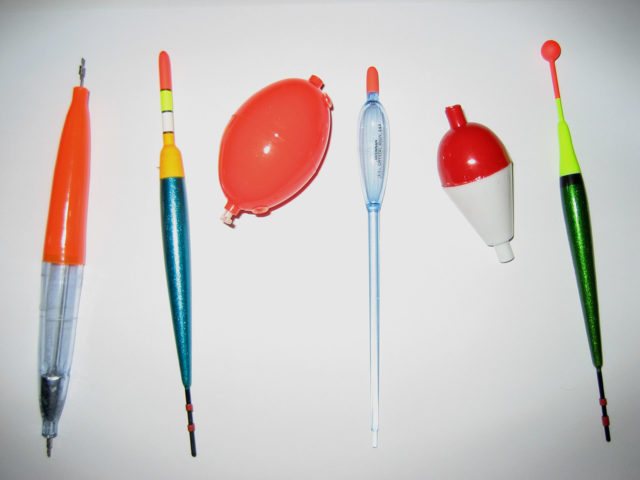
There are two approaches to choosing a float
The advantage of this type of gear is the ability to use rods with any characteristics - you can even use bamboo or hazel.
In a more modern approach, the fishing line should be taut, slightly bending the tip of the rod, and the bite is detected based on its movements. The float must be of minimal weight. Its task is to make thin fishing line more visible to the angler. This type of fishing is best suited to slightly stiff rods with a soft tip, and the concept of their use is close to the feeder rod.
Bottom tackle varieties
There are many types of donks: zakidushki, with a spring, rubber shock absorbers, feeder and bottom equipment and others. Let us consider in detail the options with a float, feeder and elastic band.
Donkeys with a feeder
Experienced fishermen know: the further you cast, the more you will catch. Large fish like to swim in depth. But what is the best way to place the bait closer to the tackle? To do this, you can use a small feeder that is attached to the tackle. The entire structure is tightly fixed with a carabiner.
You can assemble the feeder yourself from wire and lead, or buy it in a store. They are inexpensive and have a large selection. When using a feeder, it is better to use the same bait on both the hook and the bait. This approach can fool even alert and large prey.
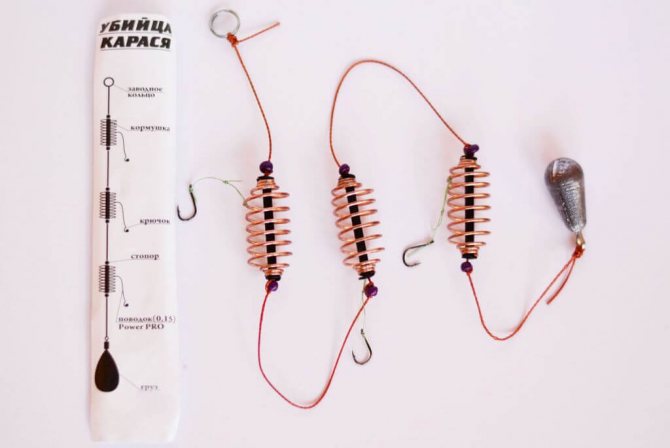
Donka with a feeder “Crucian carp killer”
Donka with a float
An ordinary fishing rod with a float, where a sliding weight is used as a sinker, fixed with a swivel or bead. The float should rise slightly above the water surface. To do this, you can dip the rod up and down for a while until the desired position is achieved. You can also load the lower tail of the float with additional weight - for example, pellets. This method of fishing is vaguely reminiscent of the bait that is usually placed on pike.
This donka has proven itself in both calm and stormy currents. Due to the reliable fixation of gear with a load, it is better suited for fast flows. A good fisherman has his own favorite way to properly assemble fishing tackle, so don’t be afraid to experiment and ask advice from more skilled comrades.
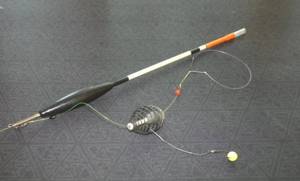
With float
With rubber shock absorbers
Fish loves silence. In order not to unnecessarily scare away the prey, fishermen usually install rubber shock absorbers on bottom gear.
Donks with shock absorbers have several important advantages:
- Repeated casting of the bait can be done over and over again without the risk of spooking the fish.
- At the same time, you can swing the bait a little to the sides to attract fish.
- The fish can be fed point by point.
- You will be able to constantly throw bait in one most successful place.
- The more leashes on the bottom tackle, the higher the chance of catching prey.
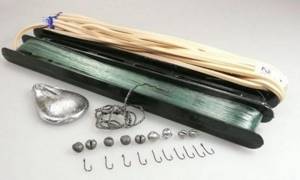
Donka with rubber shock absorber
However, this method is not without its drawbacks. Frequent use of shock absorbers quickly wears out the rubber. We recommend regularly monitoring the condition of the material and changing it in a timely manner.
Difficulties may occur during the first cast. To avoid this, fishermen usually row a boat to the fishing spot and carefully lower the weight and bait into the water. A foam float tied to a sinker will work well. Then it will be possible to catch the gear, even if the fishing line breaks.
Before you start fishing, you need to carefully equip your gear. Two reels must be attached to the donk with an elastic band. A safety cable is attached to the first one, a shock absorber and the main fishing line are attached to the second one. When placing the reels on the gear, you need to maintain a distance of 5 meters between them.
Before casting a donkey, you should estimate how many turns of fishing line will be required. During the casting process, you must first unwind the upper turns. Otherwise, the fishing line may become tangled and break.
It is important to remember that the belay rope should be unwound several meters further than the main fishing line.
The correct order for placing gear looks like this: first, the bottom gear with a shock absorber is cast, and only then you need to put the fishing line with bait.
You can connect individual elements with a carabiner. After catching it is better to remove it. The weight is removed from the bottom with a safety rope. Experienced fishermen recommend storing equipment with a shock absorber on other reels. Then it will last longer. Watch the video on how to tie a hook.
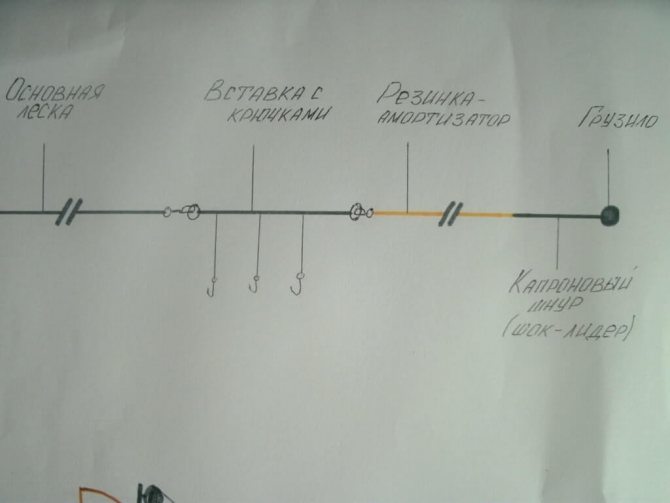
Elastic band diagram
How to make a half-donk yourself?
A do-it-yourself half-bottom is made both in the case of converting a conventional float fishing rod due to the requirements of fishing conditions, and in the case of special creation of a separate tackle.
In the first option, it is enough to move the float closer to the tip of the rod so that it is above the water and, possibly, add a sinker if the existing one is not enough. It is advisable to install an easily removable sinker so that you can easily return to the float version of the tackle. An example of such weights would be a lead plate or a lightweight feeder with a knotless connection. As a rule, such re-equipment occurs while fishing.
In the second option, it is possible to make the gear more effective and comfortable. It is advisable to choose a fishing rod with rings (Bolognese) made of carbon fiber or composite. Such rods, in addition to being lighter, have a more suitable action.
The rod is equipped with a reel, fishing line, an alarm float and a mounting of a sinker or feeder of suitable weight with a leash and hook. It is not rational to use several hooks in the tackle, because this will not improve the result, but will increase the likelihood of a hook.
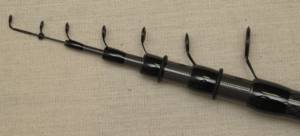
A fishing rod made of carbon fiber or composite has a more suitable action
A little about bottom rigs
Depending on the fishing conditions and the intended catch, the equipment of the bottom fishing rod also changes, but it does not greatly depend on the type of fishing rod. In total, there are several main options for bottom installations:
- for catching a predator;
- the same with a metal leash;
- multi-hook garland;
- feeder equipment;
- montages with smokestacks.
Predator mounting
To catch predatory bottom fish, such as burbot or catfish, the following setup is used:
- a sinker of sufficient weight is tied to the end of the main fishing line with a diameter of 0.30–0.45 millimeters to hold the tackle in the current;
- Above the load, 30–50 centimeters, a leash 30–50 centimeters long with a hook for the selected bait is attached.
Pike installation
This installation is distinguished by the use of several leashes, which are made of fishing line braid or soft metal wire. Alternatively, a fluorocarbon or Kevlar elbow. A sinker is tied to the end of the main line, and leashes are attached above it at intervals of 40–60 centimeters.
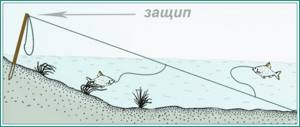
When installing the tackle, it is important to make a line loop and place it in the tuck made on the stand. When biting, the pike will pull off the fishing line, the reserve of which is enough to protect the tackle from a break.
Baits and lures for fish
In half-bottom fishing, almost the entire range of attachments and baits for bottom and float fishing is used, with the exception of live bait, as well as boilies and pellets. When fishing for large carp and predatory fish, other gear is more suitable.
The most effective are baits and lures that stick well to the hook, because the sensitivity of the half-bottom is inferior to float gear, and soft baits like semolina will often be knocked down by fish.
Most often, half-bottoms are baited on a hook:
- worm;
- maggot;
- grasshopper;
- barley;
- corn;
- peas.
In addition to the listed attachments and baits, you can use many others, focusing on the season and preferences of the fish in a particular body of water. For example, bloodworms and caddisfly larvae are effective in early spring, and a little later - dragonfly larvae.
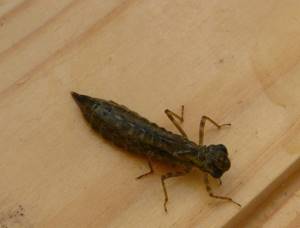
Almost the entire range of attachments and baits is used in half-bottom fishing
Components of a bottom fishing rod
- Rod.
Any rods are suitable. They must withstand the weight of the equipment when casting, so they take into account the test parameter. In calm waters with a test load of about 60 g, the length of the rod is more than 2 m. On large rivers - up to 140 g and 3 meters, respectively. - Fishing line.
You have to hunt with a bottom fishing rod in a variety of conditions; the main requirement for a fishing line is its versatility and ability to withstand the fight against large prey. For perch, roach, bream, crucian carp, silver bream and other fish that are not too large and not distinguished by fighting qualities, a fishing line with a diameter of 0.3-0.35 mm and a slightly thinner leash are quite suitable. For large fish, silicone fishing lines with a diameter of 0.35-0.50 mm are often used. The usual length of fishing line is 30-40 m. Using spinning gear in bottom fishing allows you to get by with a relatively thin fishing line, but it is wound on a spool or drum of a reel that is twice as large. - The sinker
is usually chosen drop-shaped, weighing up to 100 grams. The shape of the sinker is decisive when casting far, and its weight helps prevent the equipment from being carried away in strong currents. - Leads
for bottom fishing rods have a length of 10 to 50 cm and a thickness of one and a half to two times thinner than the main fishing line. The shorter the leash, the better, it gets less tangled. - Hooks
are chosen with the expectation of large fish - sharp, ensuring self-hooking. It's better to use doubles. When fishing with maggot or pearl barley, choose a short hook No. 10-14. A hook with a long shank No. 6-8 is suitable for a worm. - The bite alarm
notifies the angler that the fish is interested in the bait. Since several gears are often used simultaneously, and fishing is often carried out at night, an important part of the equipment is a bite alarm. The most common of them is a bell attached to the end of a fishing rod, with a niche for lighting. A vertically placed rod is also a good signal of a bite. - Float
. The equipment of a bottom fishing rod intended for fishing with live bait includes a float. It keeps the bait fish in a certain layer of water, and also prevents it from hiding in shelters. - Rod stand
. A necessary option is a stand for the rod. Sometimes it’s just a peg or a flywheel; when fishing on a river, a butt holder is needed. Racks can be single or triple.
How to choose the right fishing spot?
Determining a suitable fishing spot is important in any type of fishing, but for half-bottom it is critical, given the rather narrow scope of its application and the short fishing distance. The best places for half-bottom are the coastal shallows of small rivers with a folded bottom and the absence of algae, snags and large stones. Large fish come to the shore along the bottom grooves to feed, especially in the morning and evening hours. The second promising place is whirlpools near steep banks with a reverse current and a depth of 2-3 m.
Read more
How to catch ide in the spring?
When choosing a fishing spot, you must also pay attention to the fact that there are no obstacles nearby for manipulating a long rod - bushes, trees, reeds. Considering that large fish, which the half-bottom is primarily aimed at, are usually careful, it is better to prepare the fishing spot in advance - this will help to avoid unnecessary noise during the fishing process.
Donk fishing methods
To properly install the gear on the shore, you will need 2 special stands, which are called stags. The fishing rod is placed on the stag so that its tip is directed to the same place where the equipment was thrown. In addition, its location should be convenient for the fisherman, who at any moment must be ready to react to a bite and make a hook. The height of the fishing rod in relation to the surface of the earth is a personal matter, but it is advisable to lower the rod lower. The end of the rod should not rise too much above the water level.
Tactics and features of fishing with a half-bottom
Speaking about fishing with a half-bottom, it is worth mentioning bait; modern fishing with hook tackle is unthinkable without it. Ready-made mixtures offered by fishing stores and homemade bait are also suitable. It is only important to take into account that when fishing at shallow depths in the coastal zone, it is better to throw it often, but in small portions - balls the size of a nut. The only exception is the starting feeding. During the fishing itself, the fall of large balls of bait, familiar to fishermen, will frighten the cautious large fish with splashes.
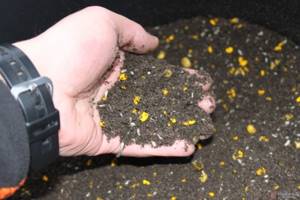
You can make bait for fishing with your own hands
The consistency of the bait should be such that the balls of it can withstand the impact of the water, but disintegrate when falling to the bottom.
If fishing with a bottom is carried out at considerable distances, which allows the angler to behave quite freely, then with a half-bottom the fish is caught almost “under your feet” and not only noise, but also unnecessary movements should be avoided, otherwise the fish can see the angler. Also, do not allow the angler's shadow to fall on the water.
Otherwise, the tactics of fishing with a half-bottom are similar to the tactics of fishing with a float rod, adjusted for the presence of conditions that prevent fishing with a float.
Fishing tactics
Having decided on the point, having prepared the half-bottom for fishing, we cast the tackle a little higher than the baited area. The weight gradually sinks to the bottom, and the current carries the hook to the baited area. The drift distance is determined by trial and error, and subsequent casts will be more accurate.
Having made sure that the tackle has stopped, we reel out the slack in the line so that after laying it on the peg it is in a taut state. Now you can install the rod on the stand and monitor the behavior of the float.
If the bite is inactive, you can cast 3-4 fishing rods at the beginning of fishing. This way, you will be able to quickly locate where a school of fish is staying. But, as practice shows, once you get into good spring fishing, one half-bottom will be enough. There is not enough time and attention for the rest.
We place the rod on the peg only after lowering the sinker to the bottom, slightly loosen the tension of the main fishing line; when the fishing line is taut, a weak bite will become unnoticeable. Therefore, the signaling device is located at a short distance from the whip.
A method for determining the type of fish by the behavior of a half-bottom float
Let's analyze the bites of several coveted trophies:
- Bream. If a large hook is taken by the hook, a strong gradual pull on the line usually follows and the float begins to tremble slightly. It is important to hook such a bite with a very short but smooth movement of the rod. Usually there are very few empty bites from large individuals. The bream immediately confidently takes the bait with the hook;
- Small underbreeders lift the hook and the line sags. It is important not to miss such a bite and it is better to hook in the direction of the current. This is due to the movement of the fish that took the bait only against the current;
- Roach. If the float begins to twitch a little with periodic small pulls on the line, this means that the desired spawning roach has come to you. Any fisherman would like such a trophy;
- The ide bite is different from all of the above. The float begins to twitch sharply and violently. Such a bite can easily throw a poorly installed rod off the stand. It is not recommended to hook after a series of jerks; it is better to wait for the repetition and at that moment hook the fish;
- The windows immediately begin to twitch the float. He twitches small and often. It is better to hook after a pause in the bite;
- When biting, ruffs cause short and small jerks of the float;
- The bite of a silver bream is similar to the bite of a bream; the line suddenly sags, and the float can sink into the water.
The float raised up does not scare away the fish. She calmly approaches the bait. This quality is especially important when fishing at shallow depths. If, after casting, your tackle is carried away by a strong current, you will need to add weight.
It is convenient to use sheet lead for this. The cut leaf weight is easily wrapped around the line and can be removed after fishing.
Using a half-bottom brings good catches not only in early spring. Summer fishing for crucian carp in thickets of aquatic vegetation, active fishing in the current during the autumn fish feast - during all these periods, a half-bottom can provide the angler with an excellent catch of different types of fish.
How to install and how to fish with a float rod with a feeder:
The donkey is installed on two supports, the tackle is pointed towards the abandoned cargo. There are no mandatory rules for the height at which a bottom fishing rod with a feeder is installed. But experienced fishermen recommend installing a float rod closer and lower to the water.
In windy weather, it is recommended to hold the tackle in your hands when throwing the device into the water until the load reaches the bottom. The line should be tight. If it sags, you need to tighten the line several times by spinning the reel. A throw with a basket tightens the fishing line worse than the load. If there is a float, it is attached near the feeder or above the sinker.
Species diversity
Half-bottom fishing is mainly designed for catching peaceful representatives of the ichthyofauna. But this approach is also suitable for catching some predators. What fish can you most often expect to catch?
- Much depends on each specific river and the species diversity in it. The most common river representative is the roach. Thanks to the half-bottom, you can enjoy fishing for fish weighing 300-500 g.
- The silver bream lives in large flocks. If she starts baiting, then a good catch will be guaranteed. Sometimes the size of a silver bream does not exceed the size of a matchbox, but record specimens weighing up to 1 kg can also be encountered.
- Dace causes the greatest delight in the angler when biting. The fish sharply grabs the bait that has fallen to the bottom, powerfully bending the tip of the fishing rod. It is important not to scare the school, otherwise there will be about a dozen silver fish in the cage.
- When using animal baits, perch becomes a common catch. Its bite is greedy and confident; you should not hesitate to hook, otherwise you will have to remove the hook from the fish’s throat.
- Near river oxbows and bays, rudd are often caught on the hook. Its bite is more aggressive compared to roach. Sometimes the fish grabs the bait while still deep in the water.
- One of the coveted trophies of midlings is bream. When a small bream bites on a small bait, you should use a voluminous bait to interest the large fish.
- In grassy coastal waters you can purposefully catch ide. This fish quickly becomes bait, which is actively used by local fishermen.
- You can successfully catch chub using a half-bottom. The bite of small individuals is sharp. But a large trophy can only slightly bend the tip of the fishing rod, which is the moment for hooking.
- On slow-flowing rivers, crucian carp bite well. The fish reacts to bait, so for a good catch you need to attract as many crucian carp as possible.
- A nice bonus when fishing with a half-bottom can be a carp bite. Often these large fish will sweep the fishing rod off the stand without prior warning.
Lure
Fish are usually fed on the surface; there are also special feeders in which bread crumbs, crackers, oatmeal or coconut flakes, breakfast cereals, special fish food, worms, maggots, etc. are placed. If the calculation is for large fish, then pieces of complementary food as in the feeder, with or without, they should be large (the size of a grain).
How to catch correctly:
It is necessary to determine the place of fishing: this can be indicated by the fish itself (walking), it is splashing in a pond or river. We throw the feeder with bait in that direction, and if the fish bites, then the float or feeder will tilt to the side, so you need to hook on the other side.
Fishing on a donk occurs in a certain order :
- Preparing for fishing bait (it needs to be soaked in water, and preferably left to soak for a short time)
- Measuring depth (you can use a special fishing rod)
- Feeding fish. The fertilizer is placed in the feeder, and after throwing it into the water, a hook is made so that the fertilizer comes out of the feeder. Then we re-compact the bait tightly into the feeder and throw it into the pond.
- The rod is installed on a stand. A bell is attached to the rig, and the line tension is adjusted if necessary.
Operating principle and scope
The half-bottom was invented by fishermen for fishing on rivers. The tackle works as follows.
The rig is thrown into a promising place, after which the current pulls the line into a straight (or almost straight) line. The sinker holds the hook with bait on the channel edge or at the exit of the hole. Previously, to detect a bite, a float was attached to a stretched fishing line near the tip of the rod. He served as a guard. When the float lowered or rose, a hook was made. Today, thanks to the flexible tip of the fishing rod, the bite is visible by the degree of its bend.
Photo 1. Classic half-bottom construction.
Using a half-bottom you can fish from spring to autumn. The gear allows you to fish both day and night in the coastal zone. If you equip the fishing rod with a heavy load, you can cast the bait at a distance of up to 20-30 m from the shore. But most often, feeding fish look for food near the shore, where fishing is carried out. The effectiveness of the tackle increases many times if you use the bait near the border with algae or next to a pool.
